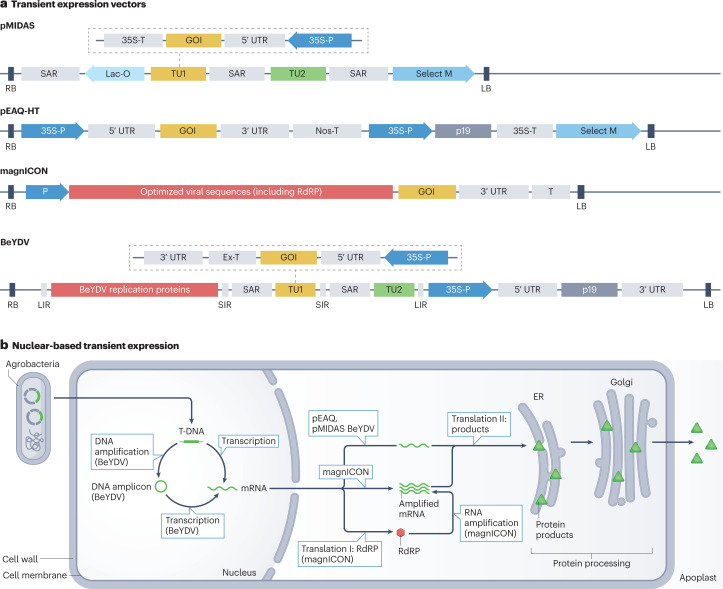Fig. 2. Transient expression in plants.
a, Plant transient expression vectors. A binary plasmid is the standard tool for nuclear expression in higher plants. Binary plasmids are composed of transfer DNA (T-DNA) borders (right border (RB), left border (LB)), cloning sites, a selection marker and replication functions for Escherichia coli and Agrobacterium tumefaciens. Transient expression vectors, including pMIDAS, pEAQ-HT, magnICON and Geminivector bean yellow dwarf virus (BeYDV), use such a plasmid backbone for foreign sequence insertion. However, the vectors differ by regulatory elements that drive gene of interest (GOI) expression. b, Nuclear-based transient expression. A. tumefaciens is used as a vehicle to deliver T-DNA to the plant cell nucleus (agro-infiltration), where mRNA is transcribed (single transcripts or multiple transcripts, depending on the expression cassettes). Prior to transcription, BeYDV-based vectors undergo a DNA amplification step by rolling circle replication in the nucleus (DNA amplification). Once transcripts leave the nucleus, they are either directly translated into proteins (pMIDAS, pEAQ, BeYDV) or undergo a (viral) RNA amplification step (magnICON) prior to translation by a specific RNA-dependent RNA-polymerase (RdRP). Engineered expression vectors, based either on potato virus X or tobacco mosaic virus sequences carry a gene coding for RdRP. Recombinant proteins (green triangles) are transported to final subcellular compartments (in case of secreted proteins to the apoplast). 35S-P and 35S-T, cauliflower mosaic virus 35S promoter and terminator; ER, endoplasmic reticulum; Ex-T, Nicotiana tabacum extensin terminator; Lac-O, lac operon; LIR, long intergenic region; Nos-T, A. tumefaciens nopaline synthase terminator; P, actin 2 promoter or 35S promoter (depending on vector); p19, tomato bushy stunt virus p19 silencing suppressor; SAR, scaffold attachment region (of diverse origins); Select M, selection marker; SIR, short intergenic region; T, either Nos terminator or no regulatory element (depending on vector); TU, transcription unit; UTR, untranslated regions (of diverse origins).

